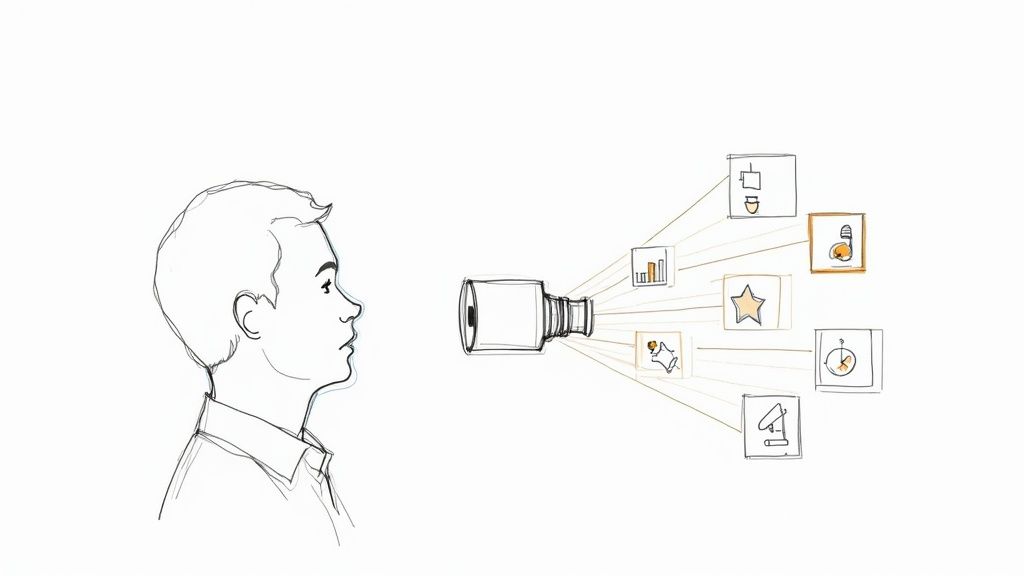An interview evaluation form is, at its core, a structured document that completely changes how you assess candidates. It’s the tool that shifts hiring from subjective "gut feelings" to objective, data-driven decisions. By using predefined, role-specific criteria and a consistent scoring system, you ensure every applicant is judged fairly on their actual merit, not just on how well they clicked with an interviewer.
Move Beyond Gut-Feel Hiring
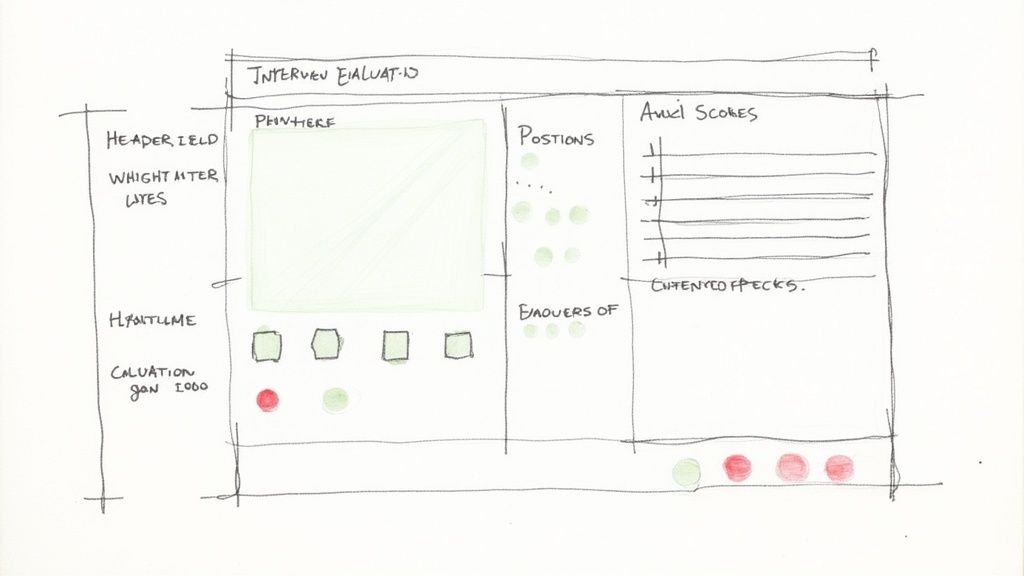
Let’s be honest: relying on instinct alone during hiring is a risky, outdated practice. It’s an open invitation for unconscious bias to creep in, where interviewers might unknowingly favor candidates who share their background or personality while overlooking more qualified individuals.
An interview evaluation form acts as a powerful counterbalance. It forces a deliberate focus on the skills and competencies that actually predict success in the role, rather than vague, subjective impressions. This isn't just about fairness; it's about making smarter, more effective hires.
Gut-Feel vs Structured Evaluation
The difference between a gut-feel hire and a structured one is stark. One is a gamble, the other is a calculated decision. Here’s a quick breakdown of how these two approaches stack up against each other:
| Hiring Aspect | Gut-Feel Approach | Structured Evaluation Approach |
|---|---|---|
| Basis for Decision | Subjective impressions, "vibe," personal connection | Objective data, scores against predefined criteria |
| Consistency | Highly inconsistent; varies by interviewer and mood | Standardized; all candidates assessed on the same rubric |
| Bias Potential | High; susceptible to unconscious and personal biases | Low; criteria are job-related, reducing bias |
| Post-Interview Debrief | Based on memory and opinion ("I liked them") | Based on evidence ("They scored 4/5 on problem-solving") |
| Legal Defensibility | Weak; lacks documented, objective reasoning | Strong; provides a clear, defensible record of decisions |
Switching to a structured evaluation is a fundamental upgrade to your entire hiring process, turning risky bets into informed investments in talent.
Creating Consistency and Fairness
Ever been in a hiring meeting where one interviewer loves a candidate and another is on the fence? Without objective data, these discussions often turn into a battle of opinions. An evaluation form provides the concrete evidence needed for a productive, fact-based debrief.
This completely transforms post-interview conversations. Instead of a manager saying, "I just got a good vibe," they can now say, "The candidate scored a 4 out of 5 on problem-solving because they walked me through a specific example of how they resolved a critical customer issue." See the difference?
This shift is more than just a good idea; it's a growing trend. In fact, about 72% of companies have already adopted structured interviews to reduce bias and improve fairness in their hiring process.
The Legal and Strategic Advantages
Beyond creating a better hiring experience, a standardized process offers crucial legal protection. Having well-documented, consistent evaluations based on job-related criteria gives you a defensible record of your decisions. It clearly demonstrates that candidates were assessed objectively, which is vital in mitigating the risk of discrimination claims.
The core benefit of a structured evaluation is moving from "who we remember best" to "who is best for the role." It's a foundational shift that impacts everything from team performance to company culture.
Ultimately, this isn't about adding more paperwork. It's a strategic move to build a more equitable, effective, and modern recruitment engine. To truly get this right, it's crucial to understand the science of culture fit and moving beyond gut feelings in hiring. This approach builds a system where merit, not personal bias, determines who joins your team.
Designing a Form That Measures What Matters
An effective interview evaluation form is so much more than a generic checklist. Think of it as a precision instrument, custom-built for the specific role you’re trying to fill. The real design work doesn't start when you open a new document; it begins with a deep dive into the job description, pushing past a simple list of duties to uncover what truly drives success in that position.
The first move is to break the role down into its most critical parts. Get together with the hiring manager, spread out the job description, and really zero in on the 5-7 core competencies that are absolutely non-negotiable. It’s tempting to create a long wishlist of every desirable trait, but fight that urge. A focused form is a useful form.
From Competencies to Measurable Criteria
Once you’ve locked in your core competencies, the next challenge is translating them into things you can actually observe and measure. This is where you turn vague ideas into concrete evaluation points. Steer clear of fuzzy labels like "Good Communicator" or "Team Player," because those mean different things to different people.
Instead, you need to define behavioral anchors for each competency. These are just specific examples of what good, average, and poor performance looks like in the real world.
- Competency: Problem-Solving
- Vague Criteria: "Good at solving problems."
- Behavioral Anchor (Score 5/5): "Candidate clearly articulated a complex problem, described the specific steps they took to analyze it, and explained the positive, quantifiable outcome of their solution."
This simple shift forces interviewers to hunt for tangible evidence instead of just going with their gut feeling.
Balancing Technical and Behavioral Skills
Let’s be honest, the best hires are a mix of both technical chops and strong behavioral skills. Your evaluation form has to be built to assess this balance. We've all seen it: the brilliant coder who can't collaborate and ends up disrupting the whole team, or the incredibly friendly teammate who can't actually do the job.
Dedicate distinct sections of your form to each of these areas:
- Technical Skills: This is for questions and tests that directly poke at job-specific knowledge. Think software proficiency tests, coding challenges, or a portfolio review.
- Behavioral Skills: Here, you'll use questions that explore how a candidate has navigated past situations related to teamwork, adaptability, and communication.
This infographic breaks down the simple yet powerful process of turning these criteria into a final, decision-making score.
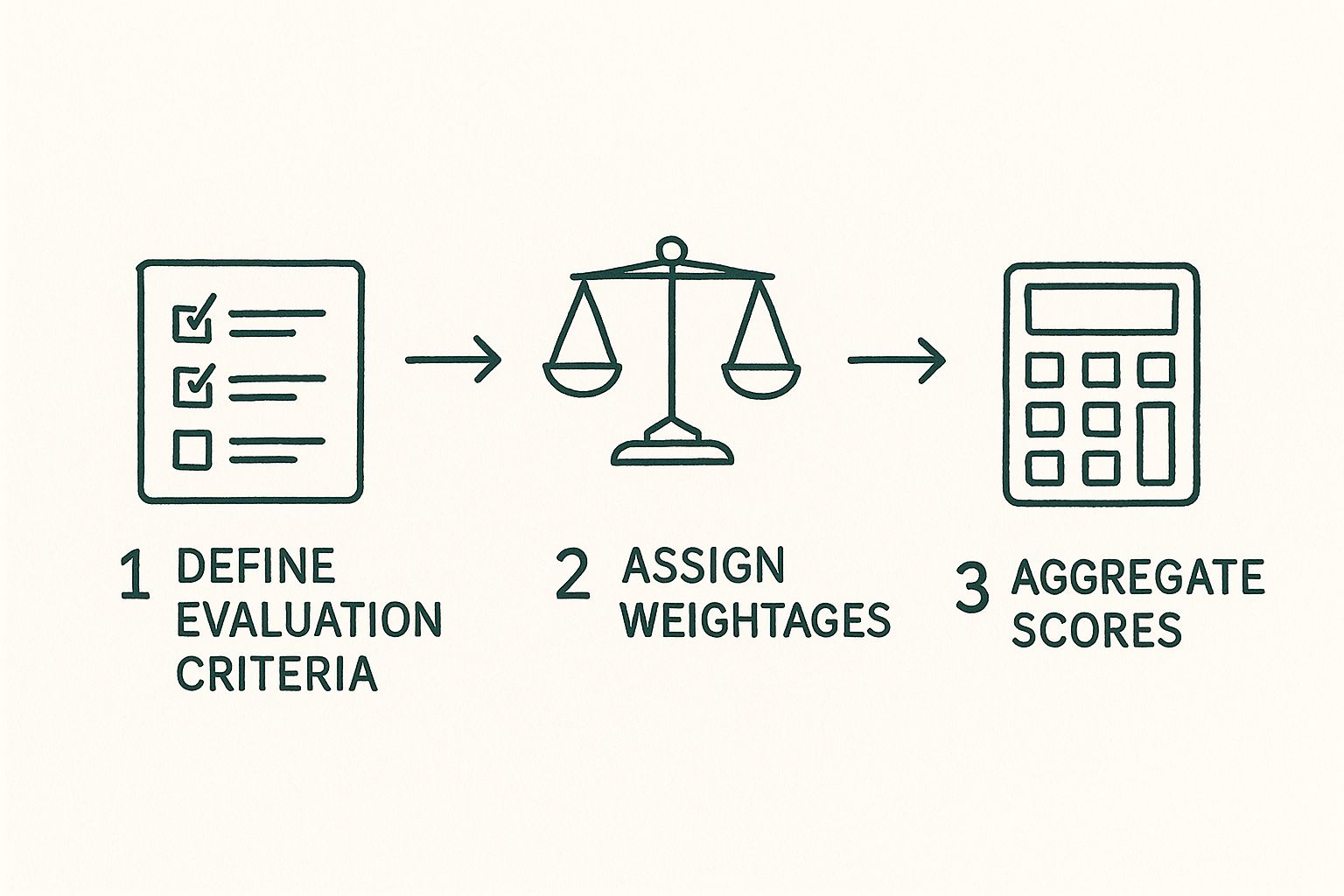
As the visual shows, a successful evaluation all comes down to defining clear criteria, weighting what's most important, and then adding up the scores to get a clear picture. This structured method gives your hiring choices a solid, data-driven backbone.
A well-designed form is the interviewer's North Star. It steers the conversation toward what actually matters, ensuring every minute of the interview is spent gathering relevant data, not just having a nice chat.
This structured approach is a game-changer in modern hiring, especially when you elevate your hiring process with on-demand asynchronous interviews. In that environment, a solid evaluation form is absolutely critical for scoring recorded responses with any consistency. It gives multiple reviewers a common language to assess candidates against the exact same standards, even if they never sit in the same room. By putting in the thought to design your form carefully, you’re building a system for making fair, intelligent, and confident hiring decisions.
Anatomy of a High-Impact Evaluation Form
A powerful interview evaluation form isn't just a checklist. It's a strategic tool. When designed well, it becomes the backbone of your decision-making process, helping you capture consistent, actionable intelligence on every single candidate.
Let’s get the basics out of the way first. Every form needs a simple header with the logistical details: candidate name, the role they’re up for, the date, and the interviewer’s name. It seems obvious, but this simple step is crucial for keeping feedback organized, especially when you have multiple interviewers weighing in.
Core Skills and Behavioral Rubrics
The real meat of the form is in its evaluation criteria. I always recommend splitting this into two distinct sections: one for job-specific skills and another for behavioral alignment. The skills section is where you get tactical, assessing the technical abilities and core competencies pulled directly from the job description.
For a software developer, you might have sections for coding proficiency, system design, and problem-solving. But just listing them isn't enough. You need to pair each competency with a clear scoring rubric, like a simple 1-5 scale. This is a game-changer for standardizing what can otherwise be very subjective assessments.
A common approach here is the Likert scale, which gives interviewers a structured way to rate performance.
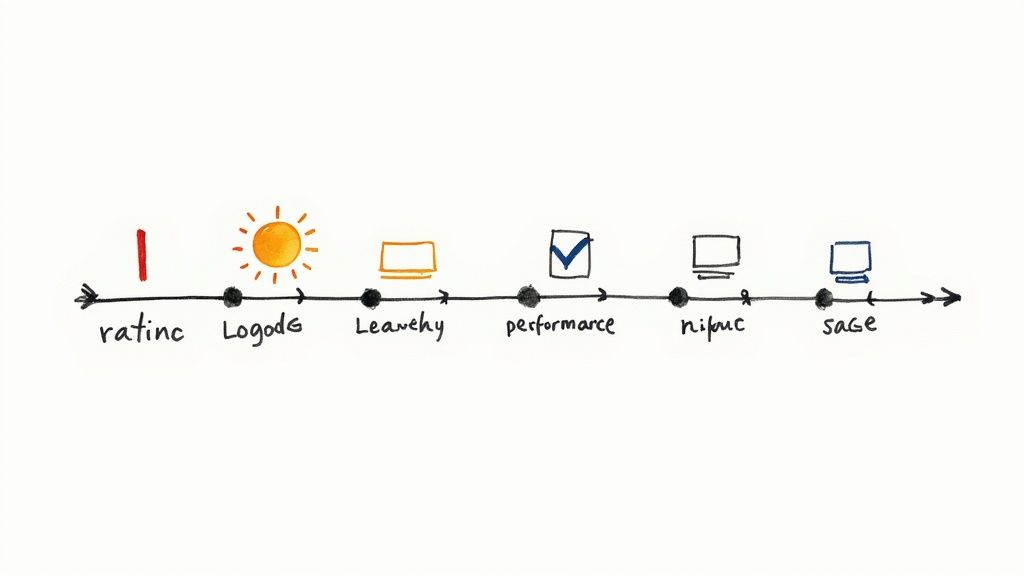
This kind of scale pushes interviewers beyond a simple "yes" or "no" and forces a more nuanced evaluation.
The behavioral section, on the other hand, is all about how a candidate lines up with your company values. This isn’t the old-school, biased idea of "culture fit"—which often just means hiring people you'd want to grab a beer with. Instead, it’s about measuring observable behaviors that tie directly to your company's core principles, whether that’s collaboration, innovation, or customer obsession.
Evidence-Based Notes, Not Vague Impressions
One of the most critical parts of any evaluation form is the space for evidence-based notes. This is where you really separate the good forms from the great ones. You have to push your interviewers to move past vague, unhelpful impressions like "good communicator" or "seemed sharp."
Your form should actively prompt them for specifics. I’ve found that including targeted questions makes a world of difference. For example:
- "Provide a specific example the candidate gave that demonstrated their problem-solving skills."
- "What evidence did the candidate offer to show their ability to collaborate under pressure?"
- "Describe the situation, action, and result the candidate shared when asked about handling project failures."
These kinds of prompts force interviewers to document the ‘what, when, and how’ behind their scores. It grounds every assessment in concrete evidence, which makes the post-interview debriefs infinitely more productive. You end up discussing actual examples, not just gut feelings.
The quality of your hiring decisions is directly linked to the quality of the data you collect. Vague feedback leads to vague decisions. Specific, evidence-based notes lead to confident, defensible hires.
Finally, every form should wrap up with two non-negotiable fields: a Final Recommendation and a Red Flags section. The recommendation field is where the interviewer has to make a clear call—think "Strongly Recommend," "Recommend," "Recommend with Reservations," or "Do Not Recommend." This forces them to take a definitive stance.
The "Red Flags" section is just as vital. It creates a dedicated space to document any concerns, no matter how small. This could be anything from a slight misalignment on values to a potential gap in a key skill. Capturing these points ensures the hiring team can address them head-on, preventing potential issues from slipping through the cracks.
Getting Your Team to Actually Use the Form
So you’ve designed a brilliant interview evaluation form. That’s a huge step, but honestly, it's only half the battle. A perfect form is completely useless if it just gathers digital dust in a shared drive somewhere.
The real challenge—and where I’ve seen so many companies stumble—is weaving it into your team’s actual day-to-day workflow. It needs to become an indispensable tool, not just another piece of administrative busywork.
The goal here is to make using the form feel less like a chore and more like a secret weapon. It should be fundamentally easier to make a great hire with the form than without it. When your team starts to see how it leads to clearer, faster, and more confident decisions, adoption will follow naturally.
Run Interviewer Calibration Sessions
Before you even think about a full rollout, you have to get your interviewers on the same page. This is where interviewer calibration sessions are absolutely non-negotiable.
It’s a deceptively simple but powerful exercise. Get the entire hiring team in a room to evaluate a sample interview together—you can use a real, recorded one or even a mock interview.
Everyone scores the candidate using the new form, and then you discuss the ratings. This is where the magic happens. You’ll immediately see where people’s interpretations differ. Does everyone truly agree on what a "4 out of 5" in communication looks like in practice? This process is critical for hammering out those inconsistencies that open the door to bias.
A calibration session isn't about forcing everyone to agree. It’s about building a shared language and understanding of the criteria. It ensures a "Strong Hire" means the exact same thing to every single person on the team.
These sessions are easily the single most effective way to make sure your evaluation data is consistent and reliable. Skip this, and you’re just collecting a pile of disconnected, subjective opinions.
Make Adoption Effortless
To get people on board, you need to remove every ounce of friction. Your team is busy. The process of filling out this form needs to be seamless.
- Create a One-Page Guide: Don’t just email the form and cross your fingers. Put together a simple, one-page guide that quickly explains the "why" behind it. Define the rating scale with clear behavioral examples (what does a "1" do versus a "5"?) and list a few best practices.
- Integrate with Your ATS: This is the game-changer. The most powerful thing you can do is build the form directly into your Applicant Tracking System (ATS). When the evaluation form is a native part of the hiring workflow—popping up automatically right after an interview is marked as complete—it becomes a natural, unskippable step.
This simple integration transforms the form from a manual task people have to remember into an automated, ingrained part of your hiring culture. When it’s part of the system, it’s no longer optional. This is often the key that unlocks widespread, consistent use across the entire organization.
Turning Evaluation Data Into Smarter Hires
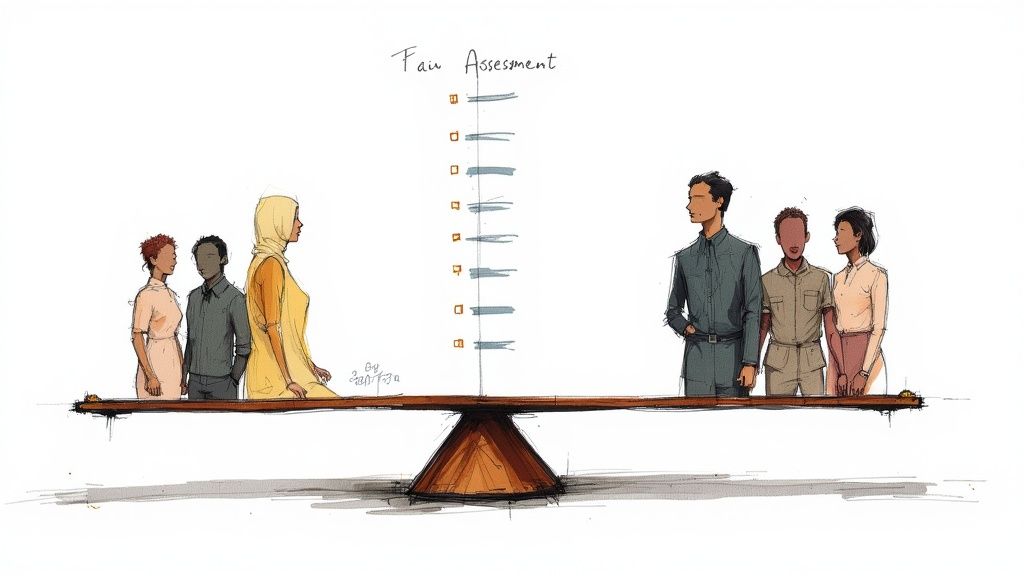
Once the last interview is done and the handshakes are over, the real work with your interview evaluation forms begins. Think of these completed forms less as records and more as a goldmine of hiring intelligence. Their true power isn't just in picking a candidate; it's in transforming raw scores and notes into a holistic, data-backed decision that strengthens your entire hiring strategy.
The first move is to gather all the completed forms for each candidate. Bringing this data together creates a complete profile, immediately showing you where your team agrees. When multiple interviewers give a candidate top marks on a key skill, you can feel confident in that assessment.
But just as importantly, this process shines a light on where opinions diverge. Did one interviewer score a candidate a 5/5 on communication while another gave them a 2/5? That’s a clear signal to dig deeper during your team’s post-interview debrief.
Diagnosing Your Hiring Process
The insights from these forms go way beyond just one candidate. Over time, they become a powerful diagnostic tool for your entire recruitment process. You’ll start to see patterns emerge across multiple interviews and different roles.
For instance, if you notice that most candidates are consistently scoring low on a specific technical competency, the issue might not be the talent pool. It could be you.
This is where you start asking the tough questions:
- Is our job description misleading or unclear about this skill?
- Are we fishing in the wrong ponds? Maybe our sourcing channels aren't reaching people with this expertise.
- Are our interview questions just not effective at uncovering what a candidate truly knows?
This feedback loop is priceless. It lets you fine-tune everything from job descriptions to sourcing strategies and interview questions, making each hiring round better than the last. You might even find it’s time to explore different interview formats, like those discussed in our guide to smart hiring with one-way and on-demand asynchronous interviews.
Closing the Feedback Loop with Candidates
This data is also a game-changer for the candidate experience. Research shows a huge communication gap: a staggering 94% of candidates want feedback, yet only 41% actually get any. That's a massive opportunity to stand out.
Using the specific, evidence-based notes from your evaluation forms, you can give all applicants—even those you don't hire—genuinely constructive and actionable feedback. It turns a rejection into a respectful and professional experience.
A great evaluation form doesn't just help you find the right person for the job; it provides the intelligence to find the next right person even faster. It turns hiring from a series of isolated events into a continuous improvement cycle.
To really get the most out of all this data, consider implementing an Applicant Tracking System (ATS). An ATS can help you manage the information from your evaluation forms, spot trends, and make these data-driven decisions part of your everyday process. When you start refining your approach based on real data, every hire becomes more strategic than the last.
Answering Common Questions About Interview Forms
Even with a perfectly designed interview form and a solid rollout plan, you're bound to get questions. It's only natural. Introducing a new process, especially one that changes how people hire, always brings up practical concerns.
A great interview evaluation form is a game-changer, but its success hinges on getting your team on board. The best way to do that is to tackle their questions and worries head-on. When managers see firsthand how a structured form leads to faster, clearer, and more confident decisions, they'll become your biggest champions.
How Do We Keep the Form From Creating New Biases?
This is a great question and a totally valid concern. The good news is that a well-built form is one of your best weapons against bias, not a source of it. The key is to keep everything laser-focused on objective, job-related criteria.
Don't just list a competency like "Adaptability." Define what it actually means for this specific role. Create behavioral anchors for each rating—what does a "5/5" look like in action versus a "3/5"?
I also recommend holding regular calibration sessions. Get your interviewers in a room to score a mock or recorded interview together. This is the single best way to make sure everyone is on the same page and interpreting the criteria consistently. Finally, make it a habit to audit your hiring data to spot any patterns that might point to bias, and use those moments as coaching opportunities.
What’s the Ideal Length for an Evaluation Form?
You're looking for the sweet spot between comprehensive and concise. In my experience, one to two pages is perfect. The goal is to zero in on the 5-7 most critical competencies for the role, not every single nice-to-have trait.
If a form is too long, you'll get interviewer fatigue. People will rush through it, and the quality of the feedback will plummet. Always aim for depth over breadth.
The purpose of a form isn't to capture every single detail—it's to capture the right details. Keep it focused, scannable, and easy to use to encourage high-quality input from your team.
A clean layout with a clear rating scale and just enough space for targeted comments is crucial. This design guides the interviewer toward what truly matters and keeps the form from feeling like a chore.
Should We Use the Same Form for Every Single Role?
Not quite. A hybrid approach is what I've seen work best. You don't need to start from scratch for every position, which would be a nightmare to manage. Instead, create a master template.
This master template should cover the universal things that apply to everyone at your company. Think about alignment with company values or core competencies like collaboration or communication.
From there, you build in customizable sections for role-specific skills. This gives you the best of both worlds: standardization and precision. You can consistently evaluate for cultural contribution while also getting a sharp, accurate assessment of the unique technical skills needed for, say, a software engineer versus a marketing manager. This is especially important when hiring remotely, which you can read more about in our guide to virtual interview tips.
Using this kind of adaptable framework helps you maintain consistency across the entire organization without sacrificing the nuance needed for specialized roles.
Ready to make your hiring process faster, fairer, and more data-driven? Async Interview provides the tools you need to streamline evaluations and collaborate effectively with your team. Discover how our platform can transform your recruitment strategy today.



